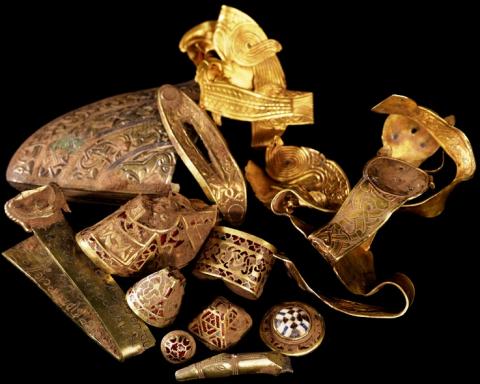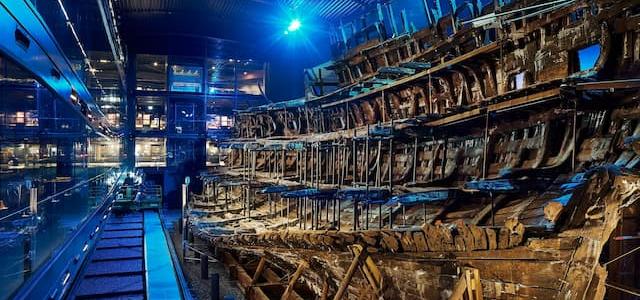
National Heritage Memorial Fund grant saves the Staffordshire Hoard
Today, the National Heritage Memorial Fund (NHMF) has announced a grant of £1,285,000 that will ensure the Staffordshire Hoard, the most important collection of Anglo-Saxon treasure ever found, is saved for the nation.

The grant, awarded to Birmingham Museum and Art Gallery (BMAG) and Potteries Museum and Art Gallery (PMAG) in Stoke-on-Trent, will fill the funding gap to reach the Hoard’s purchase price of £3.285million and means this outstanding collection will remain in the West Midlands close to where it was discovered in July last year.
Dame Jenny Abramsky, Chair of NHMF, said: “We’re delighted to be able to announce this news today. The Staffordshire Hoard is an extraordinary heritage treasure. It is exactly the sort of thing the National Heritage Memorial Fund was set up to save, stepping in as the ‘fund of last resort’ when our national heritage is at risk, as a fitting memorial to those who have given their lives in the service of our nation. We’re delighted, in our 30th anniversary year, to be able to make sure it stays just where it belongs, providing rare insights into one of the more mysterious periods of our history.”
Culture Minister Margaret Hodge said: “This is fantastic news. The great thing about the National Heritage Memorial Fund – and the reason we fought so hard to maintain its funding for next year in a tight economic climate – is that it can move quickly to help save items at very short notice. The Staffordshire Hoard is a great example of this. Thanks to this grant, these superb items will be able to stay – and be enjoyed – where they belong: in the Midlands where they were discovered.”
News of the NHMF grant marks the end of a high-profile three-month campaign led by The Art Fund. There has been remarkable public interest and the campaign successfully raised £2million, which is testament to the strength of feeling across the country that the Hoard should stay in the UK.
Historian David Starkey said “This news from the National Heritage Memorial Fund is wonderful. The Staffordshire Hoard provides us with vital clues to our ancient past and now we can set about decoding them. I’m delighted that all the other funding bodies and the generous public have helped save these breathtaking treasures for posterity.”
Stephen Deuchar, Director of The Art Fund, said: “We have been absolutely bowled over by the enthusiasm and fascination the Staffordshire Hoard has sparked amongst the British public, as well as visitors from abroad. It is wonderful news that the NHMF has enabled the target of £3.285m to be reached ahead of schedule, and I hope that this will give the West Midlands a head-start with the next stage in fundraising for the conservation, research and display of the treasure.”
The Staffordshire Hoard, containing over 1,500 objects predominantly of a martial nature, is believed to date from around the 7th century AD. In total, the Hoard is made up 5kg of gold and 1.3kg of silver - topping the record set by the Sutton Hoo find in Suffolk. Experts believe that, due to the high quality of craftsmanship displayed on the items, they may have been made for royal ownership. These riches provide new insight into the Anglo-Saxon people and a better understanding of the role the Mercia region.
The Hoard will undergo a period of research and conservation before going on permanent display in Birmingham and Stoke-on-Trent. Both Museums are working closely with two major institutions to explore the potential of lending items for display at other venues.
Councillor Martin Mullaney, Birmingham City Council, speaking on behalf of BMAG, said: “It is great achievement to secure the hoard for the West Midlands Region. I have been overwhelmed by the public response and can’t thank enough everyone who has given and supported our campaign in helping us bringing the Hoard home.”
Councillor Hazel Lyth, Stoke-on-Trent City Council, speaking on behalf of PMAG, said: “This grant from the National Heritage Memorial Fund caps a phenomenal fundraising campaign which has highlighted how proud and determined the local community has been to keep the Staffordshire Hoard in the region. This is great news for the whole country. But it is just the beginning. We now need to call on further public support to help raise more money for the equally important tasks of interpreting and researching the hoard so we can begin to unlock the secrets held within this amazing collection."
In addition to the money required to purchase the Staffordshire Hoard, a longer term fundraising strategy will now be underway to raise a further £1.7million for vital conservation and research work to take place.
Notes to editors
Funding to acquire the Hoard
National Heritage Memorial Fund £1,285,000
Public appeal £900,000
Trust’s and foundations £600,000
The Art Fund £300,000
Birmingham City Council £100,000
Stoke City Council £100,000
Total cost of the Hoard £3,285,000
The Art Fund
The Art Fund is the UK’s leading independent art charity. It offers grants to help UK museums and galleries enrich their collections; campaigns on behalf of museums and their visitors; and promotes the enjoyment of art. It is funded from public donations and has 80,000 members. Since 1903 the charity has helped museums and galleries all over the UK secure 870,000 works of art for their collections.
The Treasure Act of 1996
The Treasure Act of 1996 is an Act of Parliament designed to deal with finds of treasure in England, Wales and Northern Ireland; it does not apply in Scotland. It legally obliges finders of objects which constitute a legally defined term of treasure to report their find to their local coroner within fourteen days. An inquest led by the coroner then determines whether the find constitutes treasure or not. If it is declared to be treasure then it becomes the property of the Crown. The Treasure Valuation Committee, an independent board of experts, then places a value on the treasure. Museums that have expressed an interest in acquiring the item then have to pay the Crown the value of the treasure in order to acquire it. The Crown then passes this payment on to the finder and the owner of the land where it was found, as a reward. Only if a museum expresses no interest in the item, or is unable to purchase it, is it given to the ownership of the finder and landowner who can retain or sell it as they wish.
'Treasure' is defined as being:
- All coins from the same hoard. A hoard is defined as two or more coins, as long as they are at least 300 years old when found. If they contain less than 10% gold or silver there must be at least 10 in the hoard for it to qualify.
- Two or more prehistoric base metal objects in association with one another
- Any individual (non-coin) find that is at least 300 years old and contains at least 10% gold or silver.
- Associated finds: any object of any material found in the same place as (or which had previously been together with) another object which is deemed treasure.
- Objects substantially made from gold or silver but are less than 300 years old, that have been deliberately hidden with the intention of recovery and whose owners or heirs are unknown.
- Under English law a landowner has sole title to any archaeological artefacts found on his or her property. Legitimate metal detectorists come to an agreement with the owners of the land they detect on to share any proceeds from treasure sales.
- Non treasure finds are the remit of the Portable Antiquities Scheme.
Further information
Natasha Ley or Alison Scott, NHMF Press Officers,
Phone: (020) 7591 6102/6032 Mobile: 07973 613 820.

